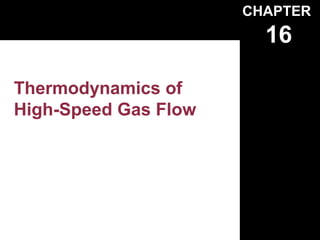
Thermodynamics Gas Flow
- 1. CHAPTER 16 Thermodynamics of High-Speed Gas Flow
- 2. Copyright © The McGraw-Hill Companies, Inc. Permission required for reproduction or display. FIGURE 16-1 Steady flow of a fluid through an adiabatic duct. 16-1
- 3. Copyright © The McGraw-Hill Companies, Inc. Permission required for reproduction or display. FIGURE 16-3 The actual state, actual stagnation state, and isentropic stagnation state of a fluid on an h-s diagram. 16-2
- 4. Copyright © The McGraw-Hill Companies, Inc. Permission required for reproduction or display. FIGURE 16-4 The properties of a high-speed fluid change significantly during an adiabatic stagnation process (values from Example 16–1). 16-3
- 5. Copyright © The McGraw-Hill Companies, Inc. Permission required for reproduction or display. FIGURE 16-5 16-4
- 6. Copyright © The McGraw-Hill Companies, Inc. Permission required for reproduction or display. FIGURE 16-7 Propagation of a small pressure wave along a duct. 16-5
- 7. Copyright © The McGraw-Hill Companies, Inc. Permission required for reproduction or display. FIGURE 16-8 Control volume moving with the small pressure wave along a duct. 16-6
- 8. Copyright © The McGraw-Hill Companies, Inc. Permission required for reproduction or display. FIGURE 16-9 The velocity of sound changes with temperature. 16-7
- 9. Copyright © The McGraw-Hill Companies, Inc. Permission required for reproduction or display. FIGURE 16-10 The Mach number can be different at different temperatures even if the velocity is the same. 16-8
- 10. Copyright © The McGraw-Hill Companies, Inc. Permission required for reproduction or display. FIGURE 16-14 The cross section of a nozzle at the smallest flow area is called the throat. 16-9
- 11. Copyright © The McGraw-Hill Companies, Inc. Permission required for reproduction or display. FIGURE 16-15 Derivation of the differential form of the energy equation for steady isentropic flow. 16-10
- 12. Copyright © The McGraw-Hill Companies, Inc. Permission required for reproduction or display. FIGURE 16-16 We cannot obtain supersonic velocities by attaching a converging section to a converging nozzle. Doing so will only move the sonic cross section farther downstream. 16-11
- 13. Copyright © The McGraw-Hill Companies, Inc. Permission required for reproduction or display. FIGURE 16-17 Variation of flow properties in subsonic and supersonic nozzles and diffusers. 16-12
- 14. Copyright © The McGraw-Hill Companies, Inc. Permission required for reproduction or display. FIGURE 16-18 When Mt = 1, the properties at the nozzle throat become the critical properties. 16-13
- 15. Copyright © The McGraw-Hill Companies, Inc. Permission required for reproduction or display. FIGURE 16-20 The effect of back pressure on the pressure distribution along a converging nozzle. 16-14
- 16. Copyright © The McGraw-Hill Companies, Inc. Permission required for reproduction or display. FIGURE 16-21 The effect of back pressure Pb on the mass flow rate m and the exit pressure Pe of a converging nozzle. 16-15
- 17. Copyright © The McGraw-Hill Companies, Inc. Permission required for reproduction or display. FIGURE 16-22 The variation of the mass flow rate through a nozzle with inlet stagnation properties. 16-16
- 18. Copyright © The McGraw-Hill Companies, Inc. Permission required for reproduction or display. FIGURE 16-26 The effects of back pressure on the flow through a converging– diverging nozzle. 16-17
- 19. Copyright © The McGraw-Hill Companies, Inc. Permission required for reproduction or display. FIGURE 16-28 Control volume for flow across a shock wave. 16-18
- 20. Copyright © The McGraw-Hill Companies, Inc. Permission required for reproduction or display. FIGURE 16-29 The h-s diagram for flow across a normal shock. 16-19
- 21. Copyright © The McGraw-Hill Companies, Inc. Permission required for reproduction or display. FIGURE 16-31 Entropy change across the normal shock. 16-20
- 22. Copyright © The McGraw-Hill Companies, Inc. Permission required for reproduction or display. FIGURE 16-33 Isentropic and actual (irreversible) flow in a nozzle between the same inlet state and the exit pressure. 16-21
- 23. Copyright © The McGraw-Hill Companies, Inc. Permission required for reproduction or display. FIGURE 16-35 Schematic and h-s diagram for the definition of the diffuser efficiency. 16-22
- 24. Copyright © The McGraw-Hill Companies, Inc. Permission required for reproduction or display. FIGURE 16-37 The h-s diagram for the isentropic expansion of steam in a nozzle. 16-23
